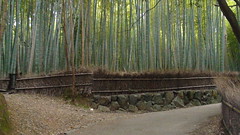Japanese Bamboo
17:02
 竹
竹Bamboo is strong and flexible, beautiful and delicious.
In Hong Kong (香港)and mainland China (中国、chugoku), it is used to build scaffolding outside skyscrapers. According to engineers, it is stronger than steel - and never rusts.
In Japan, bamboo is used as a decorative element in both architecture and garden design. It is also used for more practical purposes, such as fencing and the arched projections (犬矢来、inu yarai)seen in front of traditional Kyoto homes that prevent stray dogs and cats from urinating on the house - and keep burglars from climbing inside.
Another highly practical use was for laundry poles. Though now made mostly of some plastic/rubber hybrid, the bamboo in the name lives on: saodake (竿竹).
Bamboo is also a culinary delicacy. Soft and delectable, bamboo shoots - takenoko (竹の子)- are an integral part of an elegant Japanese meal.
In Japan, it is also said that a bamboo grove is the safest place to be during an earthquake (地震、jishin).
In Kyoto (京都), the most famous of all bamboo groves is to be found in Arashiyama(嵐山). The famed bamboo forests are just off the main drag north of Tenryuji Temple(天竜寺). The paths pictured here lead up to the Okochi Sanso Villa (大河内山荘)and many other temples and sites.
The forests are dark and cool even on the hottest day of summer. The wind rustles the majestic poles of dark green making a clack clacking noise far above us.
© Japan Visitor
 Yahoo Japan Auction Service
Yahoo Japan Auction ServiceBook a Japanese Hotel with Bookings
Japanese Friends
Rough Guide To Japan
Tags
Japan Tokyo Kyoto Bamboo Japanese
コメントを投稿